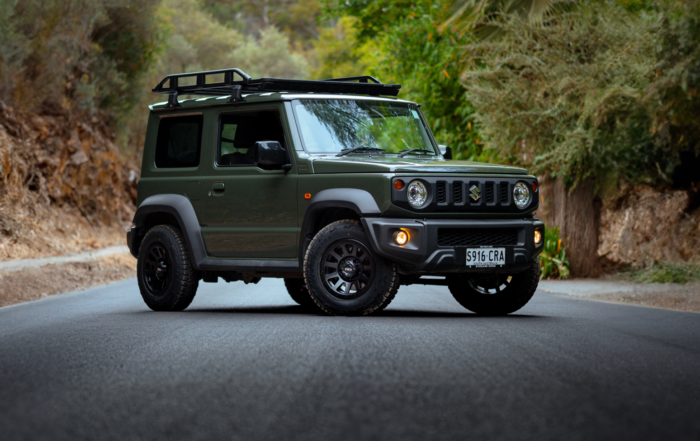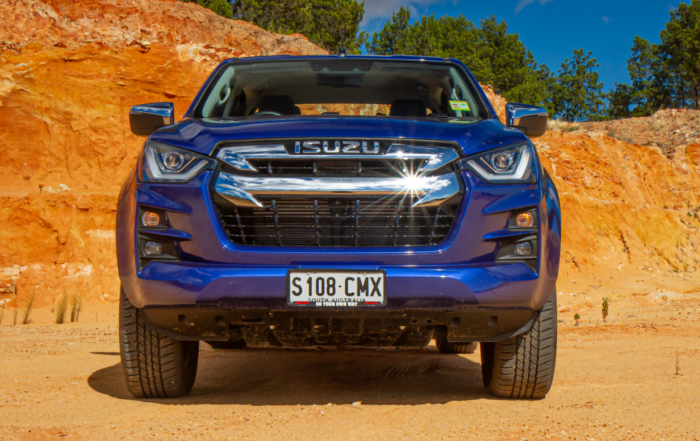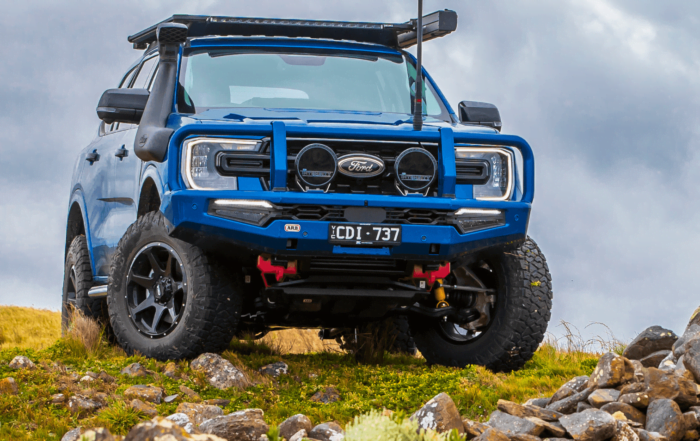2022 Isuzu D-MAX LS-U+ Review
2022 Isuzu D-MAX LS-U+ Review
I can still remember the first current generation D-MAX I drove. It was winter in 2020 (I think) and we’d recently been set free from the first round of Covid lock-downs. Isuzu’s I-Venture Club had managed to squeeze in one of their training days up at Eagle View just a little east of Adelaide, and the first of the all-new D-MAXs was there. I spent most of the day driving it and came away thinking that it was a huge leap forward for Isuzu, and that’s exactly what it’s proven to be.
I even looked at buying one for a little while at the time, but the poorly calibrated AEB (Autonomous Emergency Braking), and one too many head snapping and heart pounding, completely unnecessary emergency braking situations, experienced on subsequent drives, put me off that idea. Which was unfortunate, as there was still plenty that I liked about the D-MAX.
In the meantime, the D-MAX has gone on to win many automotive industry awards, that I take with the pinch of salt they barely deserve. I’ve seen how the industry works, who sits at what tables at award events, and how advertising packages are sold, on the night, to the winners. If you’re looking to buy a new car, ignore the awards, put your bum in the seat of whatever cars take your fancy, and go for a drive. That’s the best way to decide which vehicle is right for you.
And that’s exactly what I did with this, at the time, recently introduced LS-U+ variant of the D-MAX.
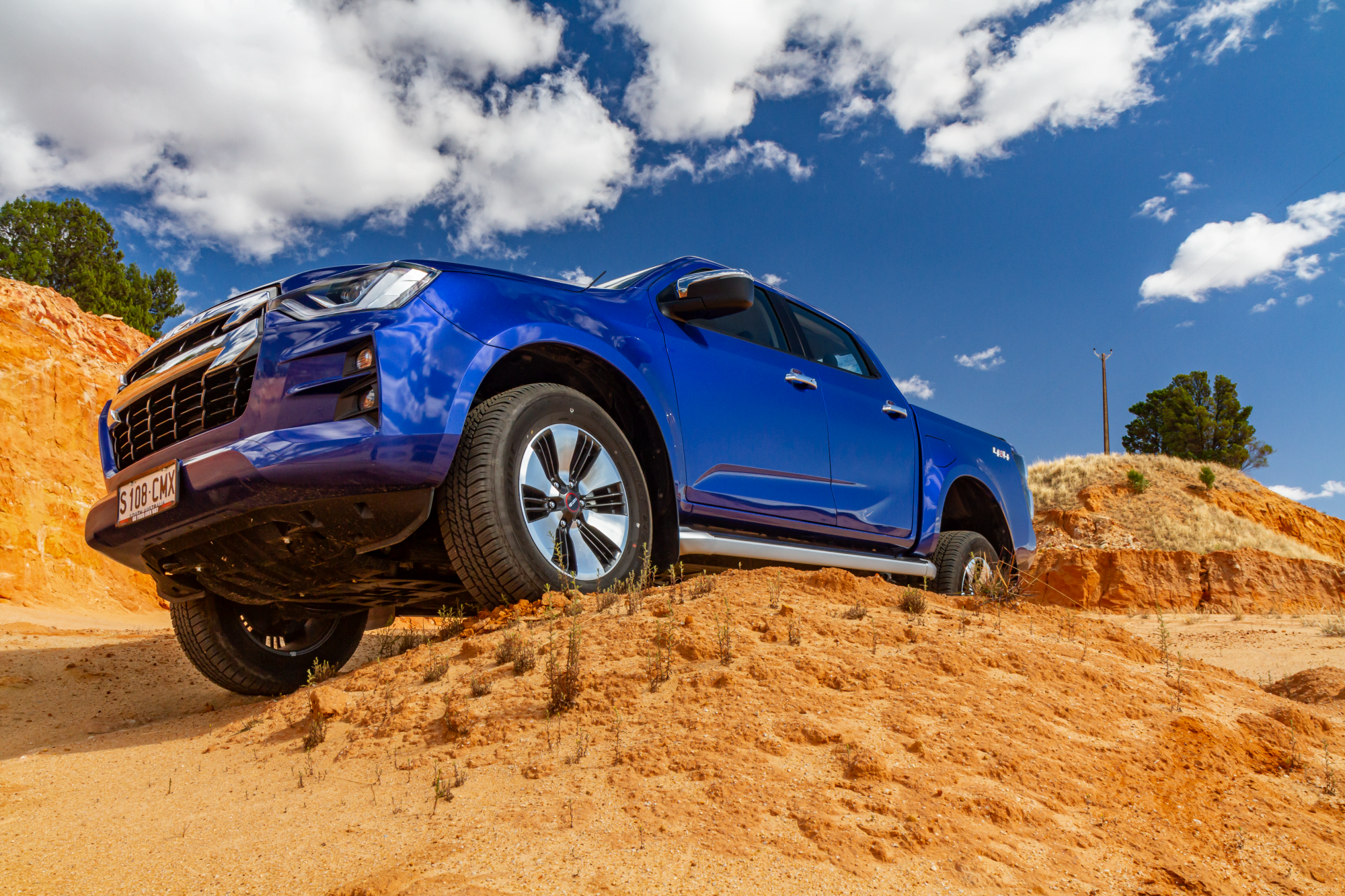
The first challenge for anyone looking at buying a new vehicle, will be coming to grips with the inflated prices, and the current D-MAX is pushing the boundaries on that score, given the basic nature of the vehicle that sits under the fancy wrapper.
As tested, this LS-U+ which adds an electric driver’s seat, front seat heating, leather accented trim and some heated mirrors to the regular, almost but not quite top-spec LS-U swag, is a whopping $69,190 drive away per Isuzu’s website, from 5051 postcode in Adelaide.
That’s a bit of coin for a cart-sprung ute.
It might seem that I’m coming across a little negative about the D-MAX, but that’s not the intention and there is plenty to like. Opening the driver’s door, reveals one of the best interiors in this segment. I’m not a huge fan of the 9” infotainment system that looks and feels a little ‘Alibaba’, or the fussy and difficult to read, central dash display, but everything else about the cabin is hard to fault in a new D-MAX. I’ve seen a few with some decent, and admittedly hard kilometres on them, and aspects of the interior don’t hold up so well, like the steering wheel and some plastic surfaces, but like any car, if you look after it, it’ll last.
The seats are comfortable, the steering wheel feels great and there’s a sense of light and space. I think most people would agree that it’s one of the best interiors available in this class of vehicle right now. Frankly, I prefer it over the Next-Gen Ranger’s interior with its surprisingly low-rent material finishes and design.
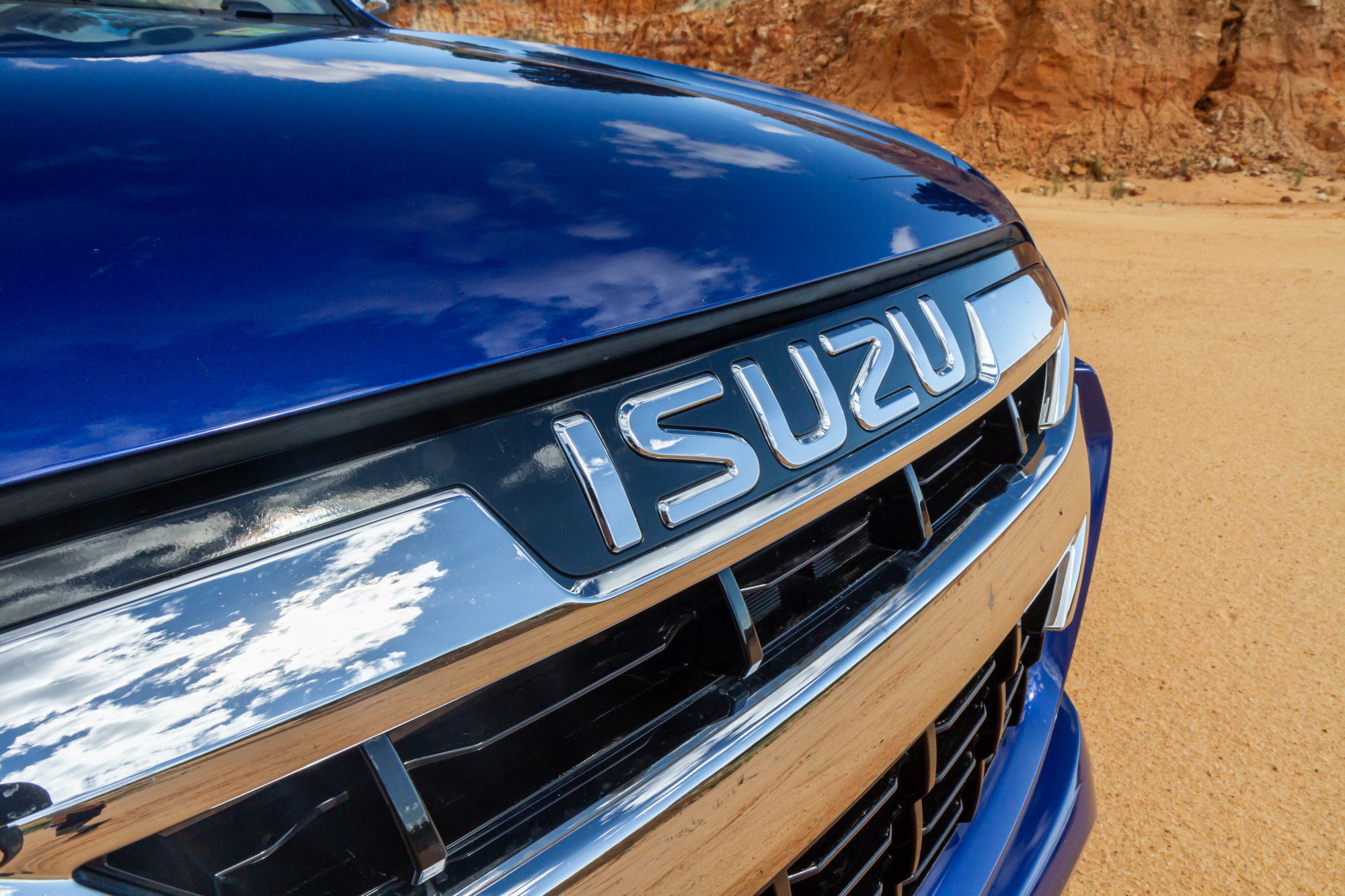
On the move, the first thing you notice at the wheel of the D-MAX is, you guessed it, the steering. The D-MAX’s electric rack dishes up a light and easy feel, albeit one devoid of any real feel, something I’m going to put down to the tyres, more than the electric steering. I’ve driven D-MAX’s setup with decent aftermarket suspension and quality all-terrain (real ATs not the fake HT ATs) and they drive noticeably better.
Isuzu has clearly targeted a softer ride in the D-MAX, and while they’ve achieved that to a large degree, it has that typically overly soft ‘clapped out Falcon taxi’ feel to it. Pajero Sport owners will know exactly what I’m talking about here.
The result is a comfortable, even plush driving experience when you first get behind the wheel, but overtime you come to realise that it’s akin to overcooked pasta, and that what you really need from your 4×4 is a little more al dente, that’s if you plan on adding any weighty accessories or doing much in the way of towing. In that regard, it’s much the same as every other 4×4 ute on the market.
Under the bonnet is the latest iteration of Isuzu’s famous truck derived 3.0-litre turbo-diesel engine, the 4JJ3 and while it’s a lot quieter than the 4JJ1 version in the previous gen D-MAX, it’s one of the noisier diesels out there. There’s also some gearbox whine, which means that the D-MAX isn’t the quietest cabin in its class, but it’ll be perfectly acceptable for all but the fussiest of owners.
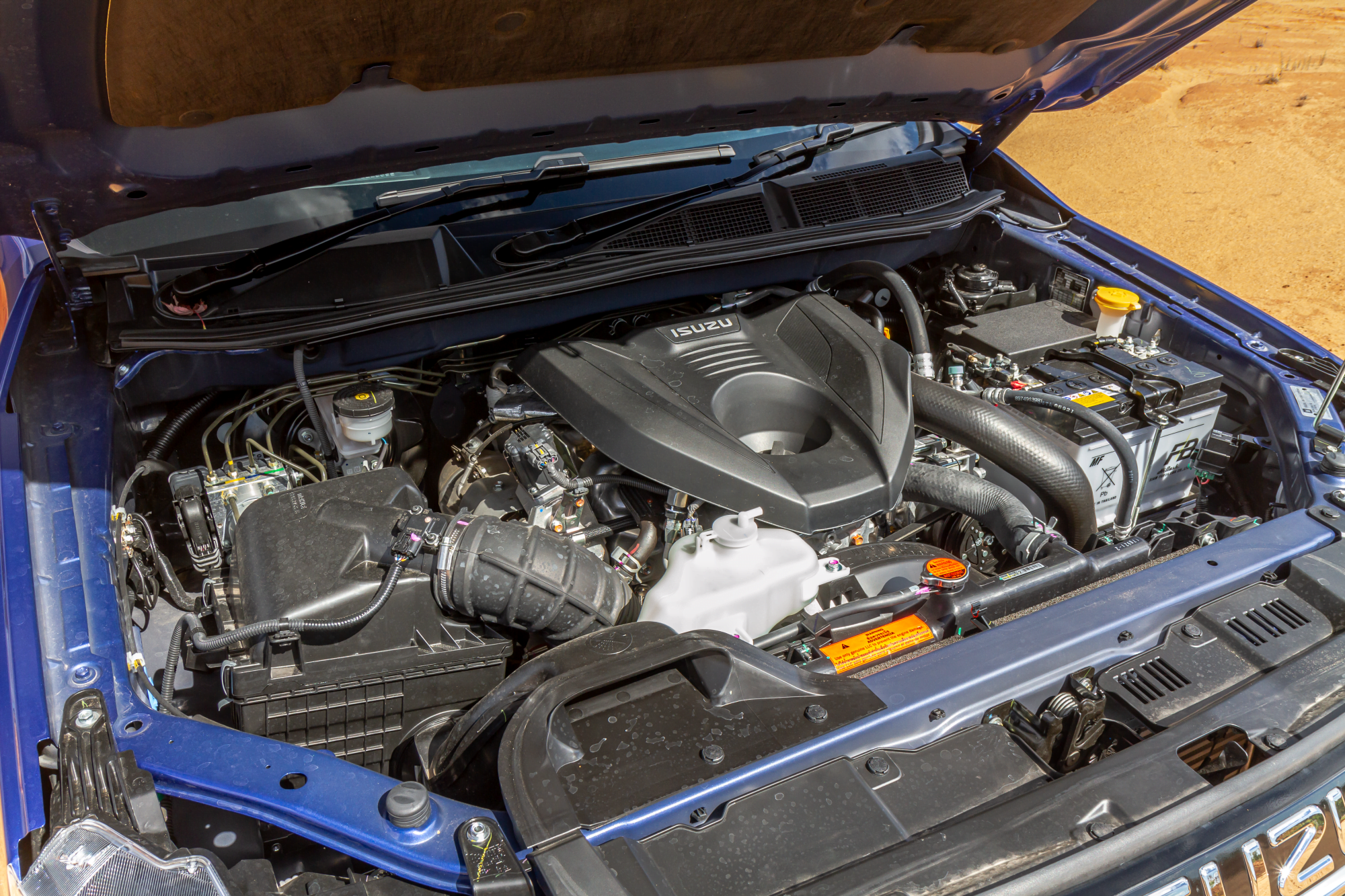
That subdued clatter only serves to remind you that up-front is one very unstressed, torquey and extraordinarily fuel-efficient engine, one that will quite possibly outlast the rest of the vehicle. If you drive a stock D-MAX sensibly, you’ll regularly see consumption in the 7 to 8lts/100km range.
We’ve run one of these D-MAXs up on a dyno and that session revealed that the 4JJ3 engine is very conservatively tuned and there’s plenty of headroom with regard to exhaust gas temperatures, making them a great tow vehicle. That’s in stark contrast to the MR Triton and it’s 2.4-litre turbo-diesel which in comparison runs hotter and works harder.
If we run with that Triton comparison, the D-MAX loses the advantage from the flywheel back. The Isuzu runs an inferior Aisin six-speed auto, to the Aisin six-speed autos used in Triton and HiLux, and it shows. This isn’t me having a grumble, I’ve been contacted by a few D-MAX owners that absolutely loathe the way the auto in their D-MAX works. It’s too quick to change down a gear and too slow to change back up when it needs to. The gear changes feel slow and lazy with up-shifts under light throttle being followed by a slight but noticeable loss of momentum as the D-MAX washes off torque it should have locked in. Compared to the Triton and HiLux, if you concentrate on how the auto gearbox is working, the D-MAX is returning the least satisfactory driving experience.

And why is the D-MAX still running an old-school part-time 4WD system?
Sure, HiLux does as well, but it’s been around in its current guise for quite a few years now, and when the all-new HiLux debuts in the next year or so, you can bank on it running an AWD/4WD drivetrain. The Triton is significantly cheaper, and it’s had the Super Select AWD/4WD drivetrain in the higher spec variants since 2008. The new MV Triton when it debuts next year will continue with the Super Select system, which means the new Navara will have it by default. Ranger and Amarok are both available with AWD functionality now as well. For the D-MAX LS-U+’s $70k asking price, the lack of an AWD/4WD drivetrain is a glaring omission in 2023.
I didn’t take this D-MAX off-road, but I’ve had plenty of time at the wheel of the D-MAX and MU-X off the beaten track. In summary, the D-MAX is still a little lacking on the low-range traction control front, although it’s much improved over the previous generation vehicle. There’s now a rear diff-lock that’s standard in the LS-U+ and that in my opinion, works better than the traction control does.
If you’re a serious off-roader and looking for the next blank canvas to modify, there are two features of the current D-MAX that probably aren’t ideal. An aluminium tail shaft has replaced the previous model’s steel version and is much easier to damage in rocky terrain. The new car also runs an alloy front diff housing (was cast steel in the previous gen car), that has catastrophically failed in some high-load off-road situations. You’ll find plenty of chatter on both topics on D-MAX related Facebook pages.

Alloy diff housings aren’t ideal in a vehicle that is otherwise designed to take you off-road. The old D40 Navara ran an alloy front diff housing, and ARB wouldn’t supply a diff-locker to suit. They believed at the time, I suspect from the outcome of prototype trials, that the alloy housing wasn’t strong enough to deal with the loads the locker would introduce.
My guess is that aluminium has been creeping into the mix to offset the weight of the additional safety and luxury features that is expected in this generation of vehicle, by buyers and ANCAP. If the additional weight isn’t offset somewhere, the vehicle’s payload is reduced, and that’s far from ideal in the 4×4 ute space.
Weight saving, no-doubt explains the thin plastic factory stone guard that covers the gearbox. If you’re using your D-MAX off-road, replacing this guard and the thin pressed steel front plates, with some real aftermarket ‘bash plates’ is a must do upgrade.
Speaking of safety, and there’s a tonne of safety kit in this generation D-MAX, one massive improvement that seems to have been introduced on the quiet, is a thorough dialling down of the collision avoidance system, which was close to being dangerous, in the earlier build press cars I’ve driven. It was so bad, it put me off buying the D-MAX at the time, and I know it’s a bone of contention with some current D-MAX owners still.
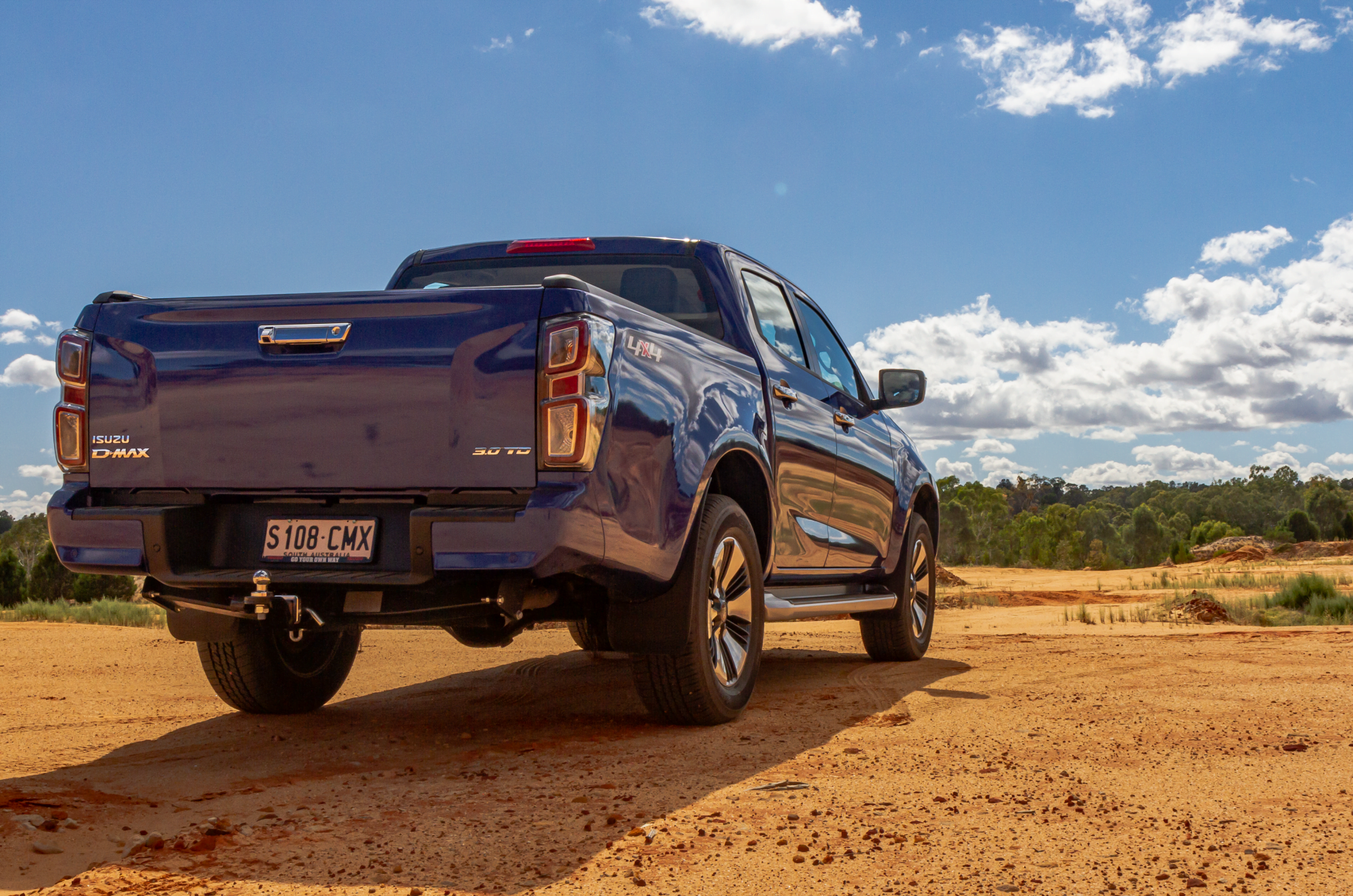
There’s also a dealer fitted button available that kills the, in my opinion, excessively interfering active Lane Keep Assist function for round town driving. I’d leave it on out on the highway though, where it really can save lives.
The cynic in me feels that this generation of the D-MAX has been designed to hit some marketing targets, like a 5-Star ANCAP rating, 9” Infotainment screen, 3.5-tonne towing, and 450Nm with 8L/100km fuel efficiency, which it has done, and won a few awards for doing.
Achieving that, has resulted in a vehicle that can be frustrating to drive at times, although this has been massively improved with the dialling down of various electronic safety elements, which just leaves the sub-par auto to deal with. It’s also compromised in some critical areas if you plan to put it to the test off-road, and of course, its missing AWD functionality, which for the money being charged, should be there.
It’s still a bloody great 4×4 ute though, and it will be on my short list when I look to upgrade the Triton in the coming years. I’ll just need some therapy to deal with the price. My top of the range Triton GSR was on the road for $51k back in 2021 and that makes all of these 4×4 utes look crazy expensive.
Isuzu D-MAX & MU-X Alloy Wheels
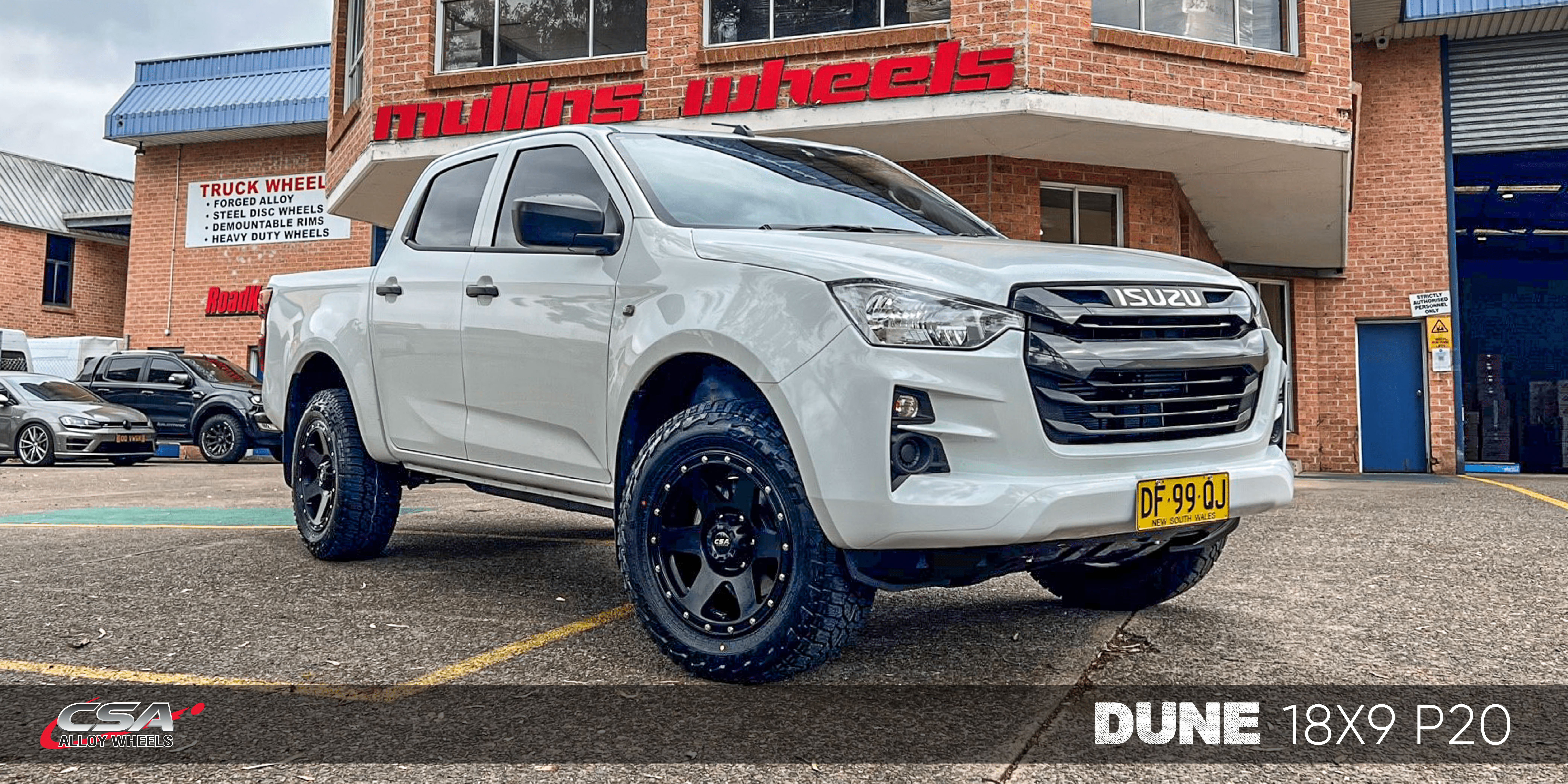
It’s not often you come across factory fresh 4x4s that have amazing looking wheels, and if you’ve got a little bit of ‘car person’ in you, changing them out for something nicer, is almost compulsory. At CSA, we have a huge range of alloy and steel wheel styles, with a range of fitments designed to work with most popular vehicles, but it’s not just about looks. Beauty as they say, is only skin deep, and our range of wheels aren’t just a visual upgrade, they’re built to take punishment in challenging conditions, deal with increased loads, and get you to the most remote places in Australia, and safely back again. Our alloy and steel wheels boast load ratings that are generally well in excess of the OEM wheels, and that makes them the perfect addition to your GVM upgraded 4×4.
If you’d like more information on CSA alloy wheels for your D-MAX or MU-X, you can find out more about the various fitments available at this link – CSA Fitment Guide – or you can get in touch with our sales team here – Contact CSA
But Wait, There’s More…
CSA Ridgeline – NEW Suzuki Jimny Fitment
I’m smitten with the JB74 Suzuki Jimny, a vehicle that despite its tiny size is absolutely huge on fun and [...]
Sizing It Up – CSA Raptor v MR Triton
The CSA Raptor wheels have been on the MitsiMates Triton for over 6 months now, and we’re still feeling the [...]
Matty Hill Chooses The Konig Hypergram
We’re excited! Our Konig Hypergram flow formed wheels have recently had their debut under Matty Hill’s S15 drift car monster [...]
2022 Isuzu D-MAX LS-U+ Review
I can still remember the first current generation D-MAX I drove. It was winter in 2020 (I think) and we’d [...]
2023 Next-Gen Ranger By ARB
Built for touring, this ARB Next-Gen Ranger build showcases the breadth of products that the off-road brand has created for [...]
2023 Next-Gen Everest By ARB
We all know that the right wheels are an integral component of any serious vehicle build, and this Ford Everest, [...]
I can still remember the first current generation D-MAX I drove. It was winter in 2020 (I think) and we’d recently been set free from the first round of Covid lock-downs. Isuzu’s I-Venture Club had managed to squeeze in one of their training days up at Eagle View just a little east of Adelaide, and the first of the all-new D-MAXs was there. I spent most of the day driving it and came away thinking that it was a huge leap forward for Isuzu, and that’s exactly what it’s proven to be.
I even looked at buying one for a little while at the time, but the poorly calibrated AEB (Autonomous Emergency Braking), and one too many head snapping and heart pounding, completely unnecessary emergency braking situations, experienced on subsequent drives, put me off that idea. Which was unfortunate, as there was still plenty that I liked about the D-MAX.
In the meantime, the D-MAX has gone on to win many automotive industry awards, that I take with the pinch of salt they barely deserve. I’ve seen how the industry works, who sits at what tables at award events, and how advertising packages are sold, on the night, to the winners. If you’re looking to buy a new car, ignore the awards, put your bum in the seat of whatever cars take your fancy, and go for a drive. That’s the best way to decide which vehicle is right for you.
And that’s exactly what I did with this, at the time, recently introduced LS-U+ variant of the D-MAX.

The first challenge for anyone looking at buying a new vehicle, will be coming to grips with the inflated prices, and the current D-MAX is pushing the boundaries on that score, given the basic nature of the vehicle that sits under the fancy wrapper.
As tested, this LS-U+ which adds an electric driver’s seat, front seat heating, leather accented trim and some heated mirrors to the regular, almost but not quite top-spec LS-U swag, is a whopping $69,190 drive away per Isuzu’s website, from 5051 postcode in Adelaide.
That’s a bit of coin for a cart-sprung ute.
It might seem that I’m coming across a little negative about the D-MAX, but that’s not the intention and there is plenty to like. Opening the driver’s door, reveals one of the best interiors in this segment. I’m not a huge fan of the 9” infotainment system that looks and feels a little ‘Alibaba’, or the fussy and difficult to read, central dash display, but everything else about the cabin is hard to fault in a new D-MAX. I’ve seen a few with some decent, and admittedly hard kilometres on them, and aspects of the interior don’t hold up so well, like the steering wheel and some plastic surfaces, but like any car, if you look after it, it’ll last.
The seats are comfortable, the steering wheel feels great and there’s a sense of light and space. I think most people would agree that it’s one of the best interiors available in this class of vehicle right now. Frankly, I prefer it over the Next-Gen Ranger’s interior with its surprisingly low-rent material finishes and design.

On the move, the first thing you notice at the wheel of the D-MAX is, you guessed it, the steering. The D-MAX’s electric rack dishes up a light and easy feel, albeit one devoid of any real feel, something I’m going to put down to the tyres, more than the electric steering. I’ve driven D-MAX’s setup with decent aftermarket suspension and quality all-terrain (real ATs not the fake HT ATs) and they drive noticeably better.
Isuzu has clearly targeted a softer ride in the D-MAX, and while they’ve achieved that to a large degree, it has that typically overly soft ‘clapped out Falcon taxi’ feel to it. Pajero Sport owners will know exactly what I’m talking about here.
The result is a comfortable, even plush driving experience when you first get behind the wheel, but overtime you come to realise that it’s akin to overcooked pasta, and that what you really need from your 4×4 is a little more al dente, that’s if you plan on adding any weighty accessories or doing much in the way of towing. In that regard, it’s much the same as every other 4×4 ute on the market.
Under the bonnet is the latest iteration of Isuzu’s famous truck derived 3.0-litre turbo-diesel engine, the 4JJ3 and while it’s a lot quieter than the 4JJ1 version in the previous gen D-MAX, it’s one of the noisier diesels out there. There’s also some gearbox whine, which means that the D-MAX isn’t the quietest cabin in its class, but it’ll be perfectly acceptable for all but the fussiest of owners.

That subdued clatter only serves to remind you that up-front is one very unstressed, torquey and extraordinarily fuel-efficient engine, one that will quite possibly outlast the rest of the vehicle. If you drive a stock D-MAX sensibly, you’ll regularly see consumption in the 7 to 8lts/100km range.
We’ve run one of these D-MAXs up on a dyno and that session revealed that the 4JJ3 engine is very conservatively tuned and there’s plenty of headroom with regard to exhaust gas temperatures, making them a great tow vehicle. That’s in stark contrast to the MR Triton and it’s 2.4-litre turbo-diesel which in comparison runs hotter and works harder.
If we run with that Triton comparison, the D-MAX loses the advantage from the flywheel back. The Isuzu runs an inferior Aisin six-speed auto, to the Aisin six-speed autos used in Triton and HiLux, and it shows. This isn’t me having a grumble, I’ve been contacted by a few D-MAX owners that absolutely loathe the way the auto in their D-MAX works. It’s too quick to change down a gear and too slow to change back up when it needs to. The gear changes feel slow and lazy with up-shifts under light throttle being followed by a slight but noticeable loss of momentum as the D-MAX washes off torque it should have locked in. Compared to the Triton and HiLux, if you concentrate on how the auto gearbox is working, the D-MAX is returning the least satisfactory driving experience.

And why is the D-MAX still running an old-school part-time 4WD system?
Sure, HiLux does as well, but it’s been around in its current guise for quite a few years now, and when the all-new HiLux debuts in the next year or so, you can bank on it running an AWD/4WD drivetrain. The Triton is significantly cheaper, and it’s had the Super Select AWD/4WD drivetrain in the higher spec variants since 2008. The new MV Triton when it debuts next year will continue with the Super Select system, which means the new Navara will have it by default. Ranger and Amarok are both available with AWD functionality now as well. For the D-MAX LS-U+’s $70k asking price, the lack of an AWD/4WD drivetrain is a glaring omission in 2023.
I didn’t take this D-MAX off-road, but I’ve had plenty of time at the wheel of the D-MAX and MU-X off the beaten track. In summary, the D-MAX is still a little lacking on the low-range traction control front, although it’s much improved over the previous generation vehicle. There’s now a rear diff-lock that’s standard in the LS-U+ and that in my opinion, works better than the traction control does.
If you’re a serious off-roader and looking for the next blank canvas to modify, there are two features of the current D-MAX that probably aren’t ideal. An aluminium tail shaft has replaced the previous model’s steel version and is much easier to damage in rocky terrain. The new car also runs an alloy front diff housing (was cast steel in the previous gen car), that has catastrophically failed in some high-load off-road situations. You’ll find plenty of chatter on both topics on D-MAX related Facebook pages.

Alloy diff housings aren’t ideal in a vehicle that is otherwise designed to take you off-road. The old D40 Navara ran an alloy front diff housing, and ARB wouldn’t supply a diff-locker to suit. They believed at the time, I suspect from the outcome of prototype trials, that the alloy housing wasn’t strong enough to deal with the loads the locker would introduce.
My guess is that aluminium has been creeping into the mix to offset the weight of the additional safety and luxury features that is expected in this generation of vehicle, by buyers and ANCAP. If the additional weight isn’t offset somewhere, the vehicle’s payload is reduced, and that’s far from ideal in the 4×4 ute space.
Weight saving, no-doubt explains the thin plastic factory stone guard that covers the gearbox. If you’re using your D-MAX off-road, replacing this guard and the thin pressed steel front plates, with some real aftermarket ‘bash plates’ is a must do upgrade.
Speaking of safety, and there’s a tonne of safety kit in this generation D-MAX, one massive improvement that seems to have been introduced on the quiet, is a thorough dialling down of the collision avoidance system, which was close to being dangerous, in the earlier build press cars I’ve driven. It was so bad, it put me off buying the D-MAX at the time, and I know it’s a bone of contention with some current D-MAX owners still.

There’s also a dealer fitted button available that kills the, in my opinion, excessively interfering active Lane Keep Assist function for round town driving. I’d leave it on out on the highway though, where it really can save lives.
The cynic in me feels that this generation of the D-MAX has been designed to hit some marketing targets, like a 5-Star ANCAP rating, 9” Infotainment screen, 3.5-tonne towing, and 450Nm with 8L/100km fuel efficiency, which it has done, and won a few awards for doing.
Achieving that, has resulted in a vehicle that can be frustrating to drive at times, although this has been massively improved with the dialling down of various electronic safety elements, which just leaves the sub-par auto to deal with. It’s also compromised in some critical areas if you plan to put it to the test off-road, and of course, its missing AWD functionality, which for the money being charged, should be there.
It’s still a bloody great 4×4 ute though, and it will be on my short list when I look to upgrade the Triton in the coming years. I’ll just need some therapy to deal with the price. My top of the range Triton GSR was on the road for $51k back in 2021 and that makes all of these 4×4 utes look crazy expensive.
Isuzu D-MAX & MU-X Alloy Wheels

It’s not often you come across factory fresh 4x4s that have amazing looking wheels, and if you’ve got a little bit of ‘car person’ in you, changing them out for something nicer, is almost compulsory. At CSA, we have a huge range of alloy and steel wheel styles, with a range of fitments designed to work with most popular vehicles, but it’s not just about looks. Beauty as they say, is only skin deep, and our range of wheels aren’t just a visual upgrade, they’re built to take punishment in challenging conditions, deal with increased loads, and get you to the most remote places in Australia, and safely back again. Our alloy and steel wheels boast load ratings that are generally well in excess of the OEM wheels, and that makes them the perfect addition to your GVM upgraded 4×4.
If you’d like more information on CSA alloy wheels for your D-MAX or MU-X, you can find out more about the various fitments available at this link – CSA Fitment Guide – or you can get in touch with our sales team here – Contact CSA
But Wait, There’s More…
CSA Ridgeline – NEW Suzuki Jimny Fitment
I’m smitten with the JB74 Suzuki Jimny, a vehicle that despite its tiny size is absolutely huge on fun and [...]
Sizing It Up – CSA Raptor v MR Triton
The CSA Raptor wheels have been on the MitsiMates Triton for over 6 months now, and we’re still feeling the [...]
Matty Hill Chooses The Konig Hypergram
We’re excited! Our Konig Hypergram flow formed wheels have recently had their debut under Matty Hill’s S15 drift car monster [...]

